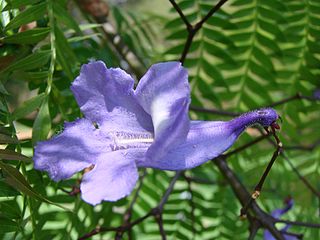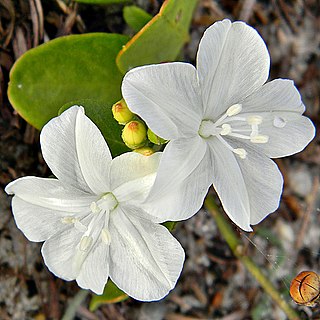
Jacaranda is a genus of 49 species of flowering plants in the family Bignoniaceae, native to tropical and subtropical regions of Latin America and the Caribbean.

Plumeria is a genus of flowering plants in the family Apocynaceae. Most species are deciduous shrubs or small trees. The species variously are endemic to Mexico, Central America and the Caribbean, and as far south as Brazil and north as Florida, but are grown as cosmopolitan ornamentals in warm regions. Common names for plants in the genus vary widely according to region, variety, and whim, but frangipani or variations on that theme are the most common. Plumeria is also used as a common name, especially in horticultural circles.

Purdiaea is a genus of flowering plants in the family Clethraceae described as a genus in 1846. It is one of two genera in this family, and was formerly classified in the related family Cyrillaceae. Purdiaea is native to tropical regions of the Caribbean, Central America and northern South America, further south than the related genus Clethra, the only other genus of this family.

Casasia is a genus of flowering plants in the family Rubiaceae. These shrubs or small trees occur on the Caribbean islands and in one case in Florida. Some of the ten accepted species were formerly placed elsewhere, e.g. in the related genip-tree genus (Genipa), in Gardenia or in Randia.
Zanthoxylum ekmanii is a species of plant in the family Rutaceae. It is found in Belize, Costa Rica, Guatemala, Honduras, Mexico, Nicaragua, and Panama.

Operculina is a genus of plants in the morning-glory family which that are found throughout the world.

Chaptalia is a genus of flowering plants in the daisy family.

Cleyera is a plant genus consisting of 21 species of tender, evergreen shrubs to small trees, mostly native to Mexico and Central America, and one from Eastern Asia. In the APG III system it is placed in the family Pentaphylacaceae.
Neobracea is a genus of plant in the family Apocynaceae first described as a genus in 1905. It was first given the name Bracea, but this turned out to be an illegitimate homonym. In other words, somebody else had already used it for another plant. Neobracea is native to Cuba and the Bahamas.
- Neobracea acunanaLippold - E Cuba
- Neobracea angustifoliaBritton - W Cuba
- Neobracea bahamensis(Britton) Britton - Bahamas, Cuba
- Neobracea ekmaniiUrb. - E Cuba
- Neobracea howardiiWoodson - EC Cuba
- Neobracea martianaBorhidi & O.Muñiz - E Cuba
- Neobracea susanninaBorhidi - E Cuba
- Neobracea valenzuelana(A.Rich.) Urb. - Cuba

Jacquemontia is a genus of plants in the morning glory family Convolvulaceae. Species in this genus are commonly known as clustervine.

Casasia clusiifolia, also called the sevenyear apple, is a species of plant belonging to the family Rubiaceae. It is common in Florida.
Casasia acunae, is a species of flowering plant belonging to the family Rubiaceae.
Casasia calophylla, is a species of plant belonging to the family Rubiaceae, it is native to Cuba.
Casasia domingensis is a plant native to the Dominican Republic, it is a part of the family Rubiaceae.
Casasia haitensis is a species of plant that is native to Haiti. It belongs to the family Rubiaceae.
Casasia jacquinioides is a species of plant belonging to the family Rubiaceae.
Casasia nigrescens is a species of plant belonging to the family Rubiaceae. It is found in Cuba.
Casasia samuelssonii is a plant belonging to the family Rubiaceae. It is found in the Dominican Republic.

Crossopetalum, commonly known as Christmas-berries or maiden berries, is a genus of flowering plants in the family Celastraceae. It comprises about 30-40 species.
Sapphoa is a genus of flowering plants in the family Acanthaceae, native to Cuba. Adapted to serpentine soils, they are nickel hyperaccumulators.









